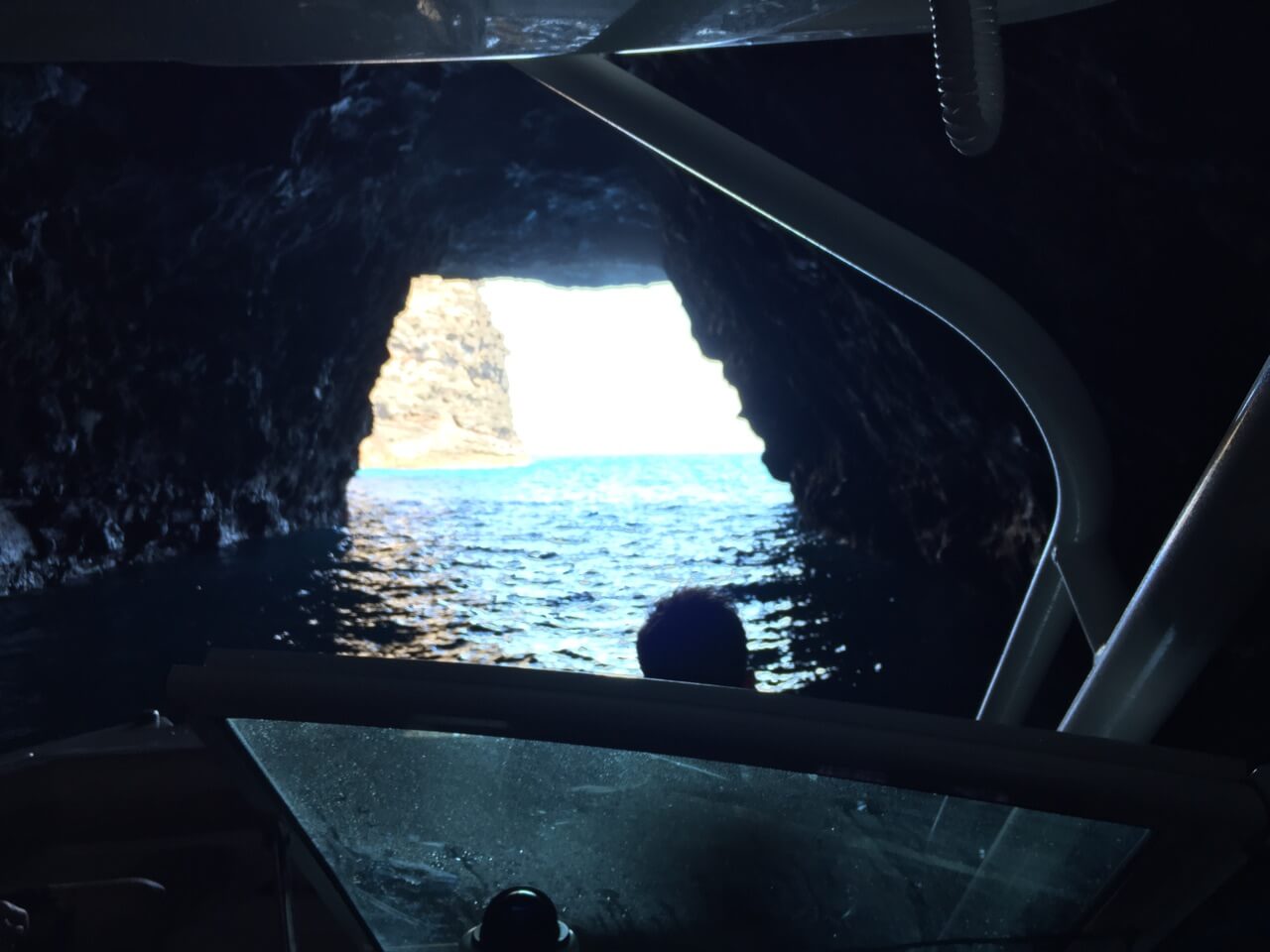Like most natural attractions in Kauai, caves are no different. They are wonderful creations of nature, waiting to be explored. And the best part — they are absolutely free.
Some of these caves are easily accessible (and easily missed because of lack of directions), while the rest demand some effort. Although the exact number of caves on the island is unknown, let’s look at the most popular ones, which have been subject to a lot of attention, worldwide.
Top 6 Kauai Caves
1. Maniniholo Dry Cave
Maniniholo dry cave is located on the north shore of Kauai. It is easily accessible as it is only a few feet off the street, across Haena beach. You can park your car at the beach parking lot, explore the cave and then head over to Haena beach for a joyful and relaxing experience.
This is a dry cave with characteristic sandy floor and low ceiling. A cavern opening up at the base of a steep mountain, Maniniholo cave stretches to about 150 ft and the ceiling gets lower as you proceed towards the end. This natural cavern was formed during the times when the sea level were higher, causing the waves to erode the cliffs, carve an opening and fill the inside with sand. In total there are three caves in the Haena region, and this phenomenon explains why it is so.
While some people find it spooky, the rest explore it with fascination and see this cave as a perfect place for a romantic getaway. Make sure you a bring along a strong flashlight as your mobile flash may not be enough to scan the cave in its entirety and explore its hidden sections.

2. Waikanaloa Cave
This wet cave in Haena State Park is in stark contrast to the dry cave we discussed above. This is called a wet cave because there is a freshwater pool inside the cave which is fed by an underground spring. And unlike Maniniholo, the Waikanaloa wet cave cannot be explored on foot.
The amount of water inside the cave depends on the level of the tides. The Waikanaloa cave is the first of the two wet caves in the area, the other one being the Waikapalae cave. Since Waikanaloa is located just off the road, it is easily accessible when compared to its sibling.
If you’ve intentions of swimming in the pool, there are two reasons not to do so. First, the stagnant pool sometimes looks and dirty and uninviting. Second, swimming is not recommended in the pool because of possible bacterial infection.
3. Waikapalae Wet Cave
This is the last of the three caves in the Haena region, and can be accessed through a small up and down hike past the Waikanaloa cave.
Waikapalae cave is also known as the blue room cave, for the colour of the water found inside. Its unique back grotto has a bluish glow to it, which is probably due to sunlight reflecting off of Calcite. The blue aura has disappeared over the years, because of decreasing water levels. However, when the tide is high and when the sun is to the north of Haena State Park, the blue light still graces its presence.
If this cave looks familiar to you when you visit, there’s a good chance you’ve seen it in ‘Pirates of the Caribbean- Stranger Tides’.
4. Makauwahi Cave Reserve
This is the largest limestone cave found in Hawaii and lies in the Mahaulepu valley, close to the Mahaulepu beach (near Gillin’s beach, to be precise.) The Makauwahi cave has been a subject of fascination for archeologists since a long time as this is considered to be the richest fossil site in the entire island. The research has led to findings of remains of ancient species of birds and fishes, along with ancient artifacts.
Due to ongoing archeological research, the Makauwahi cave is closed most of the time. If you’re keen on learning more about the history and geology of this cave reserve, plan to visit on a Sunday. This way you will have a stationed interpreter educate you on all the vital details concerned to this site.
The Makauwahi cave can be accessed via a short detour along the Mahaulepu Heritage Trail. Otherwise, it’s a short walk from Gillin’s beach.
5. The Double Door Cave

This has to be the most beautiful sea cave in the Napali region. The double door cave is also the second longest sea cave in the world.
The beautiful patterns on the inner walls of the cave, which were formed due to erosion, make one awe at nature’s brilliance. After a short distance of entering the cave, there is a small opening on the cave roof, which allows sunlight and a stream of falling freshwater inside the cave. The waterfall is great to cool off, and the natural spotlight will help you see the depositions that rise up when freshwater meets the ocean.
The cave gradually ends into a double door, seemingly separated by a cliff partition.
6. Open Ceiling Cave

The moment you enter this cave in the Napali area, you will feel as if you’re inside a gladiator arena. The open ceiling cave was once a closed hollow lava tube. Overtime, due to erosion by the powerful sea waves, the ceiling collapsed and created the marvel that we see today. The fallen portion of the ceiling can be found at the center of the pool and be intimately observed.
The cave opening is much smaller when compared to its magnitude. The open roof allows an abundance of sunlight to fall on the pool, forming a visually appealing Color palette.
Conclusion
These caves are culturally important sites of Kauai and a subject of awe for tourists who come to visit them. Like all the natural wonders on the island, these caves deserve to be kept clean and treated with respect.
The sea caves in the Napali coast can only be accessed by boating or kayaking. We at Makana Charters have small sized catamarans that are ideal if you plan on getting more intimate with the Napali sea caves. Our 27′ Cat is full of luxury settings, very beautiful, has smooth riding, and plush seating all across the board. If your group has 6 or under and looking for an intimate ride we can bet you’ll be very satisfied! She is equipped with fresh water shower, on-board restroom, very plush seating, and much more!
Click here for detailed information on all our boat tours

Note: This article was originally published on 22 October 2022. It has since been updated regularly for relevance and freshness.
Related Articles


Comments
Before the tsunami in 1958 you could drive a truck 8 miles into the cave at Haena. It was not created by higher sea levels. It was most definitely a lava tube.